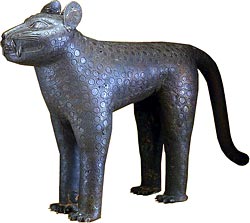| |
|

|
 |
 |


|
 |

Memorial Tusk
Late 18th-early 19th century
(Kingdom of Benin)
Ivory
Miscellaneous Works of Art Fund
|
Look
- Tell the story of Ezomo Ehenua. Would you say this tusk tells that story, or does it, instead, represent the outcome?
What symbols tell of the outcome?
An ezomo holds a sword in his right hand to signify his military prowess. The oba above the ezomo has an elephant trunk in each hand, to symbolize his strength and dominance over the rebellious elephant-chief.
- An
ATTRIBUTE
is a distinctive symbolic feature that identifies a character. Find the attributes of the ezomo: elephant symbols,
REGALIA,
and sword. Use the detail. Find the attributes of the oba: elephants' trunks, regalia, and the leopard.
- The elephant is the dominant character in this story . How is he represented?
Find three bent lines (his forehead) and the long curving line in the center of the tusk, of which many straight lines
emanate (his trunk).
|
|
Think
- Recall the story of Ezomo Ehenua.
What part do elephants play in the Edo myth?
Iyase n'Ode could turn himself into an elephant.
Why are elephants so important to the Edo people?
A source of ivory and also the most powerful animal in Africa.

|
|
Leopard
Benin
17th century
Bronze
The Minneapolis Institute of Arts |
- In Edo culture, certain animals are associated with royalty. Elephants are associated with rulers and royalty because of their
physical strength. The leopard is an animal associated with the Benin oba.
What characteristics does a leopard have that an oba might want?
Cunning, speed, agility, intelligence, grace.
- Each carving of a person or animal on this tusk is an instant reminder to a Nigerian viewer of the story of Ezomo Ehenua.
What would a picture of a stern queen and seven dwarfs remind you of? A young lion in the company of a meerkat and a warthog?
What pictures might you use to recall the literature book you/we are reading?
- Edo people understand even the most
ABSTRACT
images on this tusk.
Why would an Edo artist want to make carvings that are easy for Edo people to identify and understand?
Edo people are reminded of their cultural history and the heritage of their rulers.
- RELIEF
is a term applied to sculpture when the figures project out from a
BACKGROUND.
The memorial tusk is an example of low relief, in which the figures project only slightly and no part is cut completely away
from the background. Although coins are not "carved," they are excellent examples of low relief. Why might an Edo artist
choose low relief for carving a tusk like this one? Consider: available tools, hardness of the medium, maintaining the original
form of the tusk. Why might an Edo artist want to maintain the original form and shape of the tusk? Recall the importance of
elephants in the Edo myth.
- What is a memorial?
Something that keeps remembrance alive.
Why do you think this is called a memorial tusk?
It recalls how good service to the oba is rewarded and reminds the Edo people of their traditional mythology.
What other examples of memorials can you think of?
Gravestones or monuments in cemeteries, the Lincoln Memorial, the Vietnam War Memorial.
|
|
|











